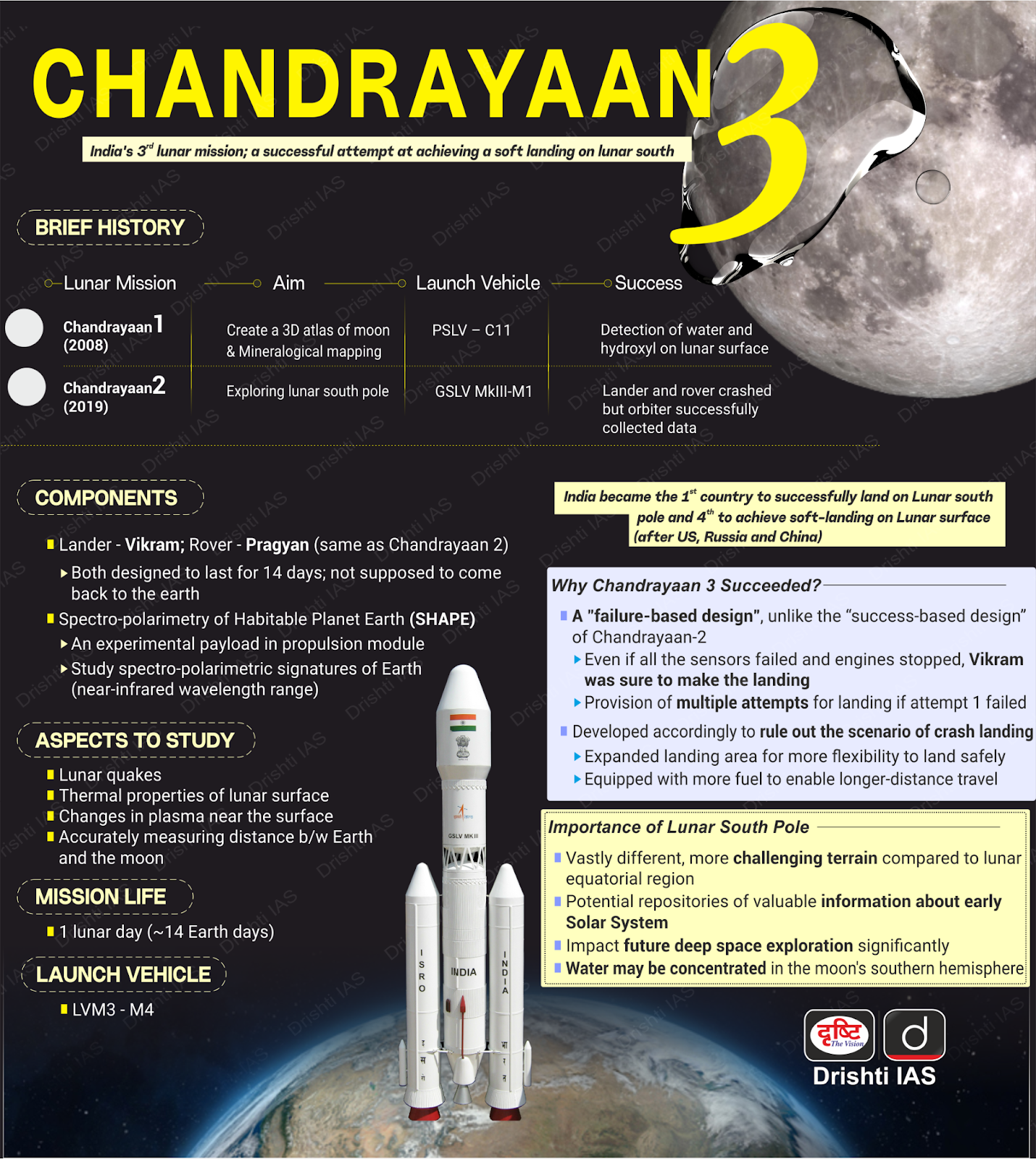Important Facts For Prelims
National Space Day 2024
- 23 Aug 2024
- 6 min read
Why in News?
Recently, India celebrated its first National Space Day on 23rd August 2024. It is celebrated to mark the safe and soft landing of Vikram Lander of Chandrayaan-3 mission, on the lunar surface on 23rd August 2023.
- Additionally, the recent findings based on Chandrayaan-3, represent the first analysis of the Moon’s southern topsoil composition and support the hypothesis of the sea of molten material on the lunar surface.
Why is National Space Day Celebrated?
- About:
- National Space Day, celebrated on 23rd August, commemorates India's space achievements, particularly Chandrayaan-3's success.
- With the launch of Chandrayaan-3 in 2023, India became the fourth nation to successfully land on the Moon and the first to reach its southern polar region.
- It highlights India's space exploration capabilities and aims to inspire future generations to pursue careers in science, technology, engineering, and mathematics (STEM), contributing to India's ongoing space endeavours.
- Theme for 2024:
- The theme for National Space Day 2024 is ‘Touching Lives while Touching the Moon: India's Space Saga’.
What are the Recent Findings of Chandrayaan-3?
- Key Findings:
- The terrain around Chandrayaan 3’s landing sight is fairly uniform.
- A sea of hot, molten rock or magma once existed under the lunar surface.
- The Moon’s crust was formed layer by layer, which supports the lunar magma ocean (LMO) hypothesis.
- The topsoil around the lunar south pole has a greater-than-expected sprinkling of minerals which compose the lower layers of the lunar crust.
- LMO Hypothesis and Lunar Crust Formation:
- The Moon is believed to have formed from a giant asteroid impact with Earth about 4.5 billion years ago, creating a molten surface that eventually cooled.
- In this process, heavier minerals like olivine and pyroxene sank to the lower crust and upper mantle, while lighter minerals like calcium and sodium-based compounds floated to form the upper crust.
What are the Highlights of Indian Space Missions in 2003-24?
- Aditya-L1 Mission:
- Aditya-L1 is the first space based observatory class Indian solar mission to study the Sun from the first Earth-Sun Lagrange point, L1.
- Gaganyaan TV-D1 Test:
- ISRO conducted its Flight Test Vehicle Abort Mission-1 (TV-D1), using a modified L-40 Vikas engine for the Gaganyaan human spaceflight mission.
- The test demonstrated the Crew Escape System (CES) capabilities, including separation from the test vehicle, crew module safety, and deceleration before splashdown in the Bay of Bengal. The module was recovered by the Indian Navy vessel INS Shakthi.
- XPoSat Launch:
- On 1st January 2024, ISRO launched the X-ray Polarimeter Satellite (XPoSat), aimed at studying radiation polarisation in space.
- The satellite is the second space-based observatory of its kind, following NASA’s Imaging X-ray Polarimetry Explorer (IPEX) launched in 2021.
- RLV-TD Experiments:
- ISRO conducted two landing experiments using a downscaled version of the Reusable Launch Vehicle, Pushpak, in March and June 2024, at its Aeronautical Testing Range Challakere, Karnataka.
- These tests simulated space landing conditions, with Pushpak being dropped from a Chinook helicopter to assess landing performance.
- SSLV Development:
- In August 2024, ISRO launched the third and final development flight of the Small Satellite Launch Vehicle (SSLV), successfully placing the EOS-08 and SR-0 Demosat satellites in orbit.
- With two consecutive successful test flights, ISRO concluded the SSLV’s development and transferred it to industry.
- Private Space Missions:
- In March 2024, Agnikul Cosmos successfully launched its SoRTeD-01 vehicle, marking the first launch of a vehicle powered by a semi-cryogenic engine as its first stage from Indian soil.
- Skyroot Aerospace is progressing towards its Vikram 1 launch vehicle.
- Dhruva Space and Bellatrix Aerospace conducted experiments on the fourth stage of the PSLV-C58 mission in January 2024, utilising the stage as an orbiting platform for their payloads.
Read more: Chandrayaan 3
UPSC Civil Services Examination, Previous Year Question (PYQ)
Prelims:
Q. Consider the following statements: (2016)
The Mangalyaan launched by ISRO
- is also called the Mars Orbiter Mission
- made India the second country to have a spacecraft orbit the Mars after USA
- made India the only country to be successful in making its spacecraft orbit the Mars in its very first attempt
Which of the statements given above is/are correct?
(a) 1 only
(b) 2 and 3 only
(c) 1 and 3 only
(d) 1, 2 and 3
Ans: (c)
Mains:
Q. Discuss India’s achievements in the field of Space Science and Technology. How the application of this technology has helped India in its socio-economic development? (2016)






-min.jpg)